About Search Recipes Adware
Search Recipes Adware is a type of infection that will constantly expose you to advertisements. It’s advertised as a legitimate extension that will help look for food recipes in an easier way, but in reality it aims to expose users to loads of advertisements. Finding good recipes is not a difficult task and you certainly don’t need a questionable extension for it. However, it’s possible that you didn’t install it knowingly, and are now wondering how it managed to get into your computer. It may have been attached to some kind of free program that you installed. This is referred to as software bundling, and it’s a popular method to spread adware, browser hijackers and other kinds of potentially unwanted programs (PUPs). You can avoid unwanted installations if you correctly install programs, which we will explain how to do in the next section of this article. 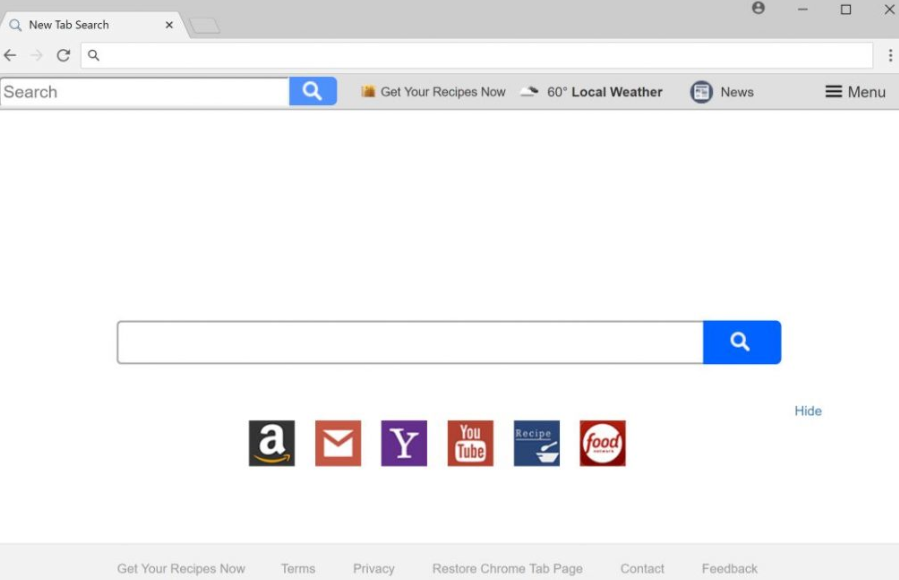
Search Recipes Adware is not malware, nor is it particularly dangerous itself. However, while such infections are generally pretty minor, they aren’t harmless either. Adware aims to make revenue, and it does so by exposing you to constant ads. Those ads are the main problem. Their security is not checked, which means they could easily lead you to scams or malware. It may be difficult to differentiate between adware ads and legitimate ones, so it would best if you avoided them altogether while adware is installed.
The adware will appear among your Google Chrome extensions so you can easily check whether you have it installed. Its logo will also appear on the toolbar on the right. You may also be constantly redirected to its search engine. If you notice it installed but have no recollection of setting it up, you should delete Search Recipes Adware.
How does adware install?
The extension is available on the Google Chrome store but it’s doubtful you stumbled upon it among all other cooking-related extensions. It also has no reviews and no ratings, which makes it a high-risk extension as you do not know what to expect.
It is more likely that you installed it accidentally when setting up some kind of freeware. Free programs often have something attached to them, including adware, browser hijackers etc. Those attached items are authorized to install alongside the free programs, and your permission is not needed. If you want to prevent these unwanted installations, you will have to pay attention to how you install freeware and manually prevent added offers from installing. When installing programs, it’s important to follow the process. However, the most important thing you need to do is opt for Advanced (Custom) settings. Those settings will make the added items visible. Once you get a list of what has been added, you only need to deselect the boxes. After you have done that, you can continue installing the program.
What does it do?
The adware will appear among your other Google Chrome extensions, so it’s pretty noticeable. It may also change your browser’s settings so that your searches are redirected to its promoted search engine. You ought to be careful with search results generated by questionable search engines, as they may include links to dubious websites. What may seem like a relevant search result could lead to malware-ridden or scam websites. You will also notice an increase in advertisements. Pop-ups, redirects, etc. will appear randomly as your browse. Just like with search engines, you need to be careful with ads as well. Adware generated ads are certainly not reliable, so be skeptical of every single one you encounter.
You may be offered to download software or updates, but be skeptical of those offers. Ads are not a reliable source for downloads, so you should never download anything from them. If you are offered a program and it seems useful, research it and if it checks out, download it from legitimate sources. Never ads.
It’s important to read the Privacy Policies of extensions in order to find out what kind of information they collect, how they store it and with whom do they share it with. If you read Search Recipes’s, you would notice that it collects personal information, supposedly for “detection and fraud detection purposes”. They can also share your data with third-parties. Since it’s not exactly a reliable extension, it having any kind of information about you should not be something you want.
If you’re looking for extensions that can help you find food recipes, there are much more reliable extensions out there. And if you didn’t install it, you should certainly uninstall Search Recipes Adware.
Search Recipes Adware removal
If you have made the decision to remove Search Recipes Adware, you can do it manually. If you are unsure about where to begin, you are welcome to use the below provided instructions to help you. Otherwise, you can use anti-spyware software for Search Recipes Adware removal.
Offers
Download Removal Toolto scan for Search Recipes AdwareUse our recommended removal tool to scan for Search Recipes Adware. Trial version of provides detection of computer threats like Search Recipes Adware and assists in its removal for FREE. You can delete detected registry entries, files and processes yourself or purchase a full version.
More information about SpyWarrior and Uninstall Instructions. Please review SpyWarrior EULA and Privacy Policy. SpyWarrior scanner is free. If it detects a malware, purchase its full version to remove it.

WiperSoft Review Details WiperSoft (www.wipersoft.com) is a security tool that provides real-time security from potential threats. Nowadays, many users tend to download free software from the Intern ...
Download|more


Is MacKeeper a virus? MacKeeper is not a virus, nor is it a scam. While there are various opinions about the program on the Internet, a lot of the people who so notoriously hate the program have neve ...
Download|more


While the creators of MalwareBytes anti-malware have not been in this business for long time, they make up for it with their enthusiastic approach. Statistic from such websites like CNET shows that th ...
Download|more
Quick Menu
Step 1. Uninstall Search Recipes Adware and related programs.
Remove Search Recipes Adware from Windows 8
Right-click in the lower left corner of the screen. Once Quick Access Menu shows up, select Control Panel choose Programs and Features and select to Uninstall a software.


Uninstall Search Recipes Adware from Windows 7
Click Start → Control Panel → Programs and Features → Uninstall a program.


Delete Search Recipes Adware from Windows XP
Click Start → Settings → Control Panel. Locate and click → Add or Remove Programs.


Remove Search Recipes Adware from Mac OS X
Click Go button at the top left of the screen and select Applications. Select applications folder and look for Search Recipes Adware or any other suspicious software. Now right click on every of such entries and select Move to Trash, then right click the Trash icon and select Empty Trash.


Step 2. Delete Search Recipes Adware from your browsers
Terminate the unwanted extensions from Internet Explorer
- Tap the Gear icon and go to Manage Add-ons.


- Pick Toolbars and Extensions and eliminate all suspicious entries (other than Microsoft, Yahoo, Google, Oracle or Adobe)

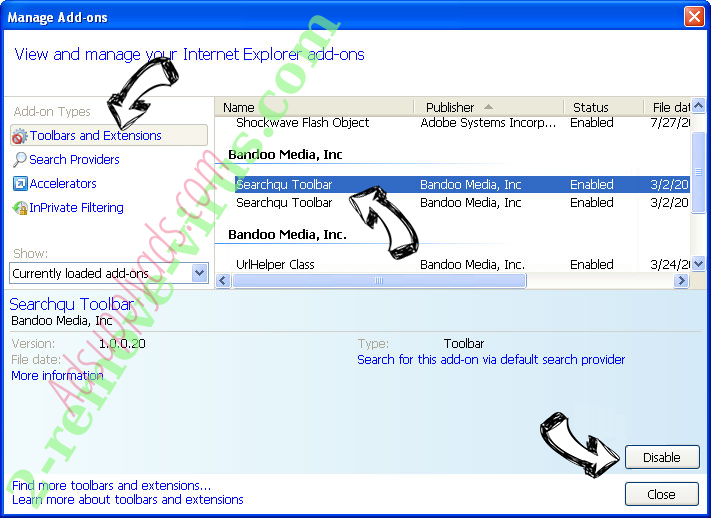
- Leave the window.
Change Internet Explorer homepage if it was changed by virus:
- Tap the gear icon (menu) on the top right corner of your browser and click Internet Options.

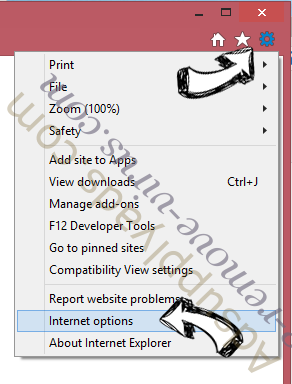
- In General Tab remove malicious URL and enter preferable domain name. Press Apply to save changes.


Reset your browser
- Click the Gear icon and move to Internet Options.

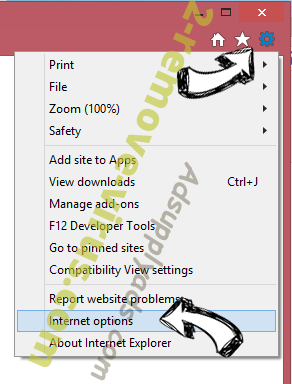
- Open the Advanced tab and press Reset.

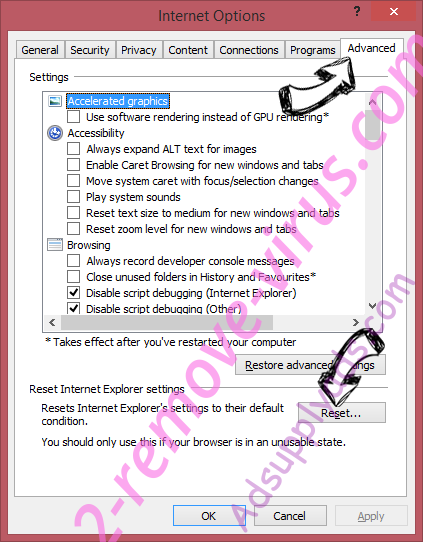
- Choose Delete personal settings and pick Reset one more time.


- Tap Close and leave your browser.


- If you were unable to reset your browsers, employ a reputable anti-malware and scan your entire computer with it.
Erase Search Recipes Adware from Google Chrome
- Access menu (top right corner of the window) and pick Settings.


- Choose Extensions.

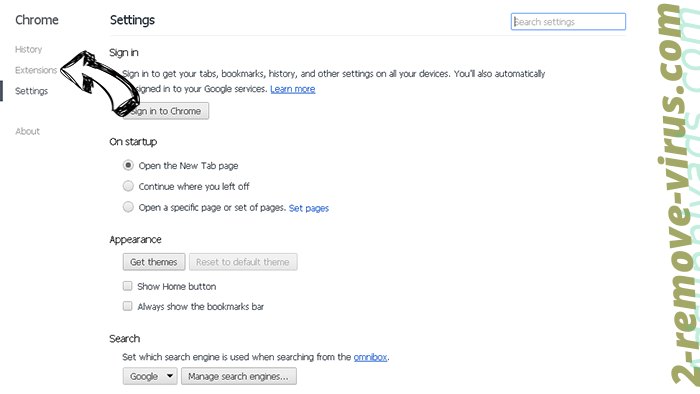
- Eliminate the suspicious extensions from the list by clicking the Trash bin next to them.


- If you are unsure which extensions to remove, you can disable them temporarily.

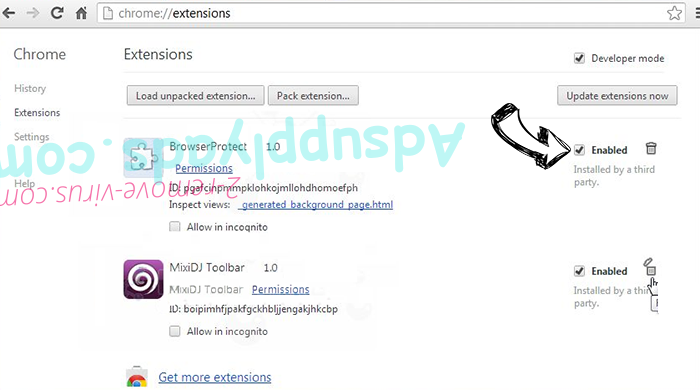
Reset Google Chrome homepage and default search engine if it was hijacker by virus
- Press on menu icon and click Settings.

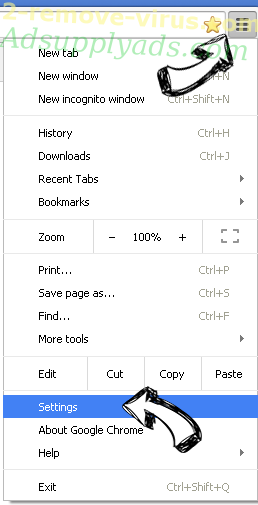
- Look for the “Open a specific page” or “Set Pages” under “On start up” option and click on Set pages.

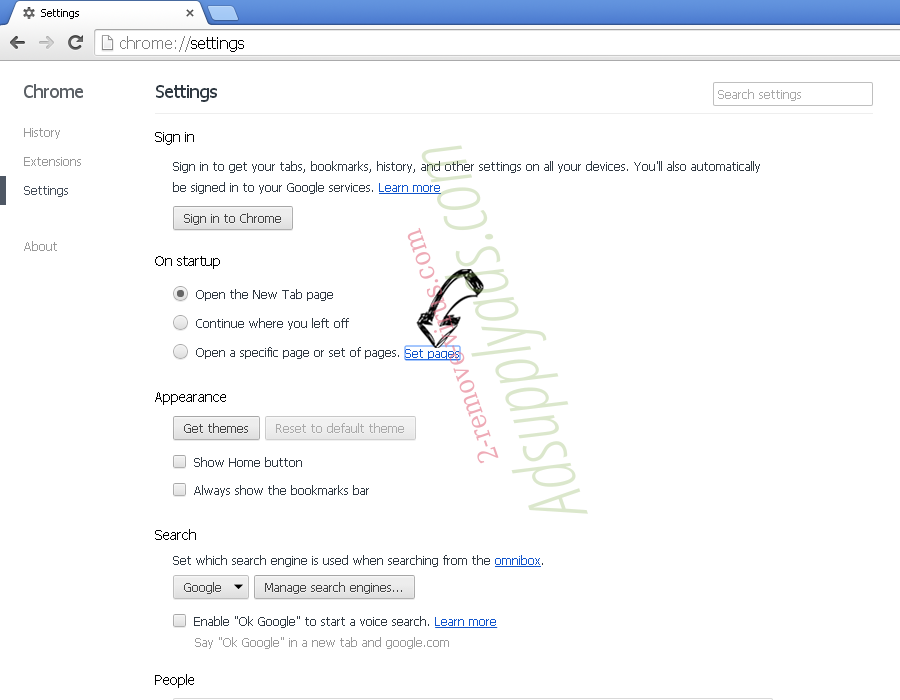
- In another window remove malicious search sites and enter the one that you want to use as your homepage.


- Under the Search section choose Manage Search engines. When in Search Engines..., remove malicious search websites. You should leave only Google or your preferred search name.

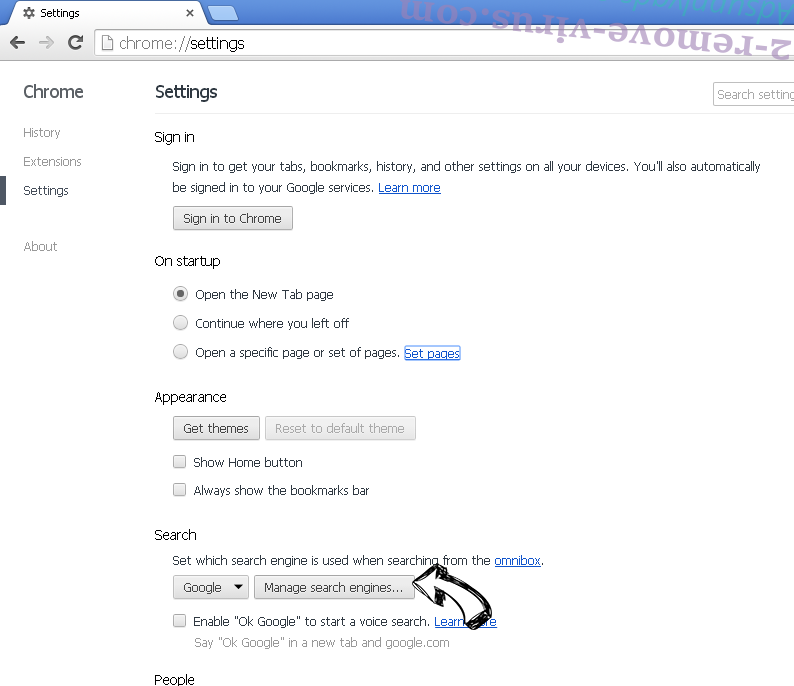

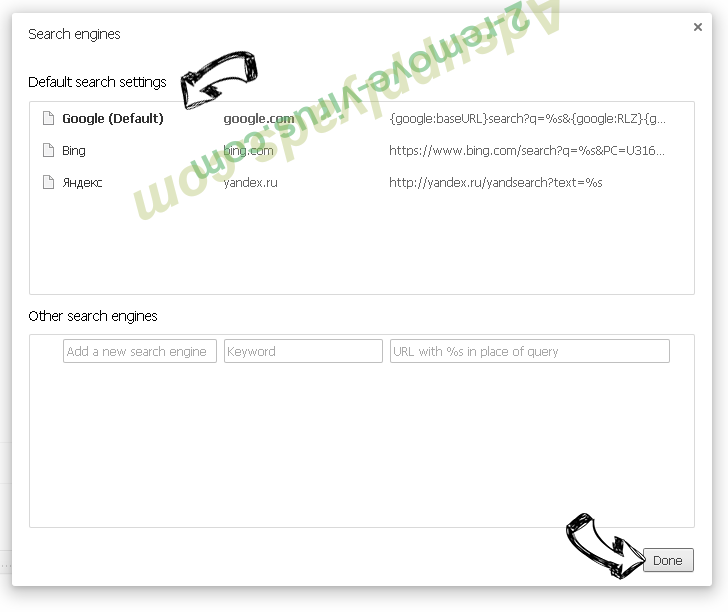
Reset your browser
- If the browser still does not work the way you prefer, you can reset its settings.
- Open menu and navigate to Settings.

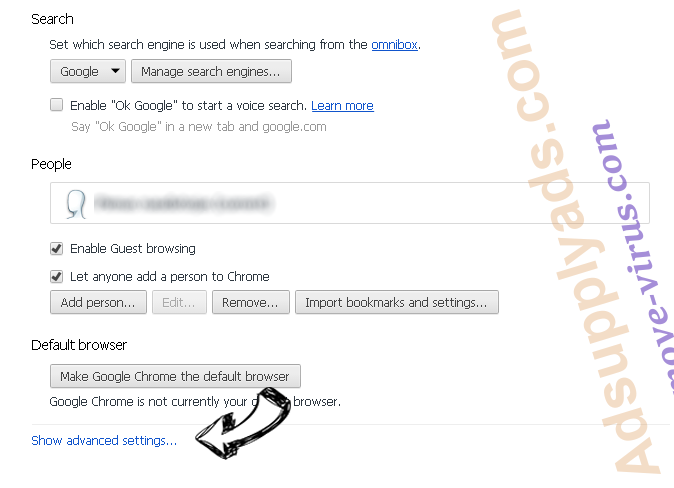
- Press Reset button at the end of the page.

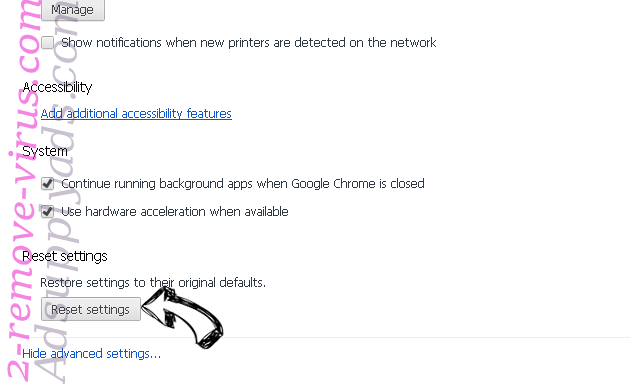
- Tap Reset button one more time in the confirmation box.

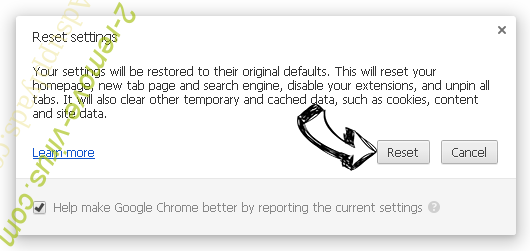
- If you cannot reset the settings, purchase a legitimate anti-malware and scan your PC.
Remove Search Recipes Adware from Mozilla Firefox
- In the top right corner of the screen, press menu and choose Add-ons (or tap Ctrl+Shift+A simultaneously).

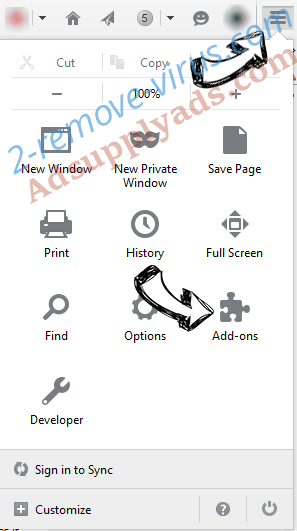
- Move to Extensions and Add-ons list and uninstall all suspicious and unknown entries.

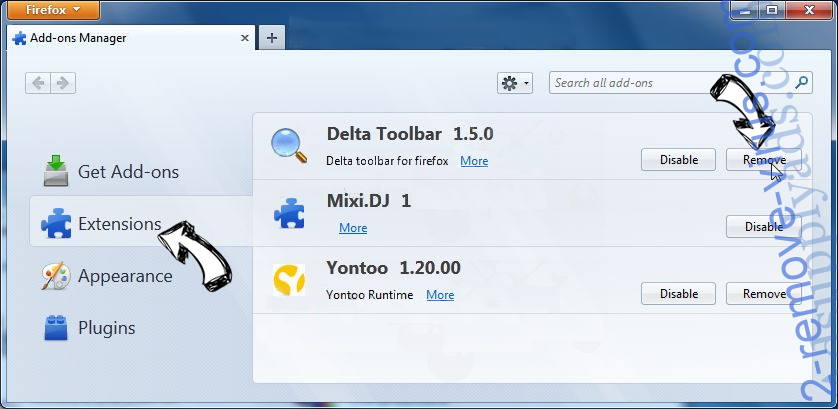
Change Mozilla Firefox homepage if it was changed by virus:
- Tap on the menu (top right corner), choose Options.


- On General tab delete malicious URL and enter preferable website or click Restore to default.


- Press OK to save these changes.
Reset your browser
- Open the menu and tap Help button.

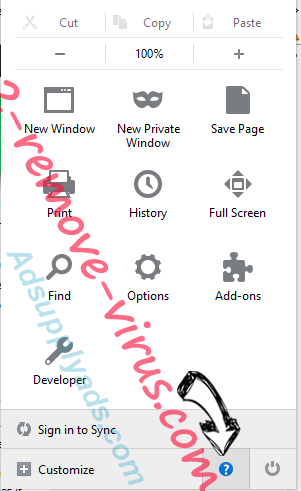
- Select Troubleshooting Information.


- Press Refresh Firefox.

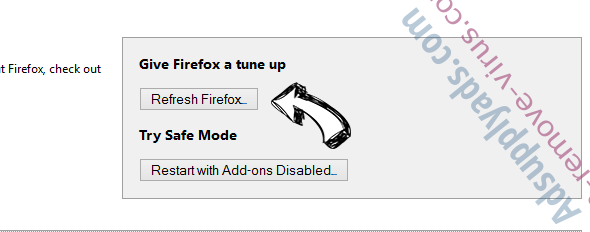
- In the confirmation box, click Refresh Firefox once more.

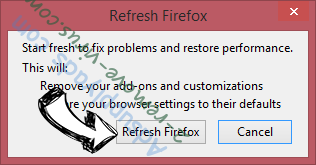
- If you are unable to reset Mozilla Firefox, scan your entire computer with a trustworthy anti-malware.
Uninstall Search Recipes Adware from Safari (Mac OS X)
- Access the menu.
- Pick Preferences.


- Go to the Extensions Tab.

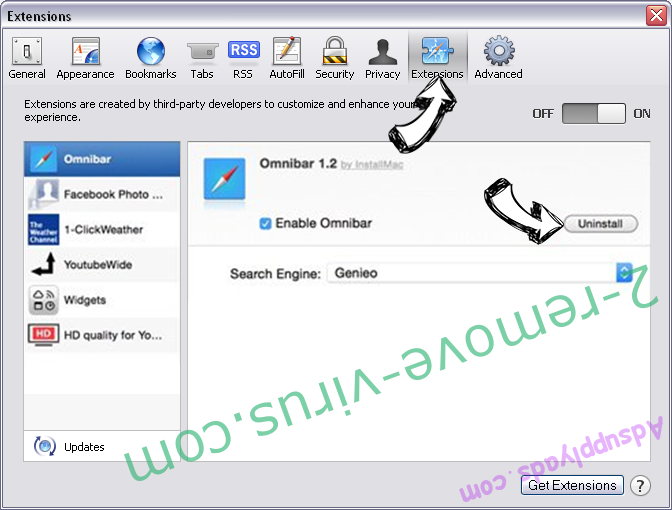
- Tap the Uninstall button next to the undesirable Search Recipes Adware and get rid of all the other unknown entries as well. If you are unsure whether the extension is reliable or not, simply uncheck the Enable box in order to disable it temporarily.
- Restart Safari.
Reset your browser
- Tap the menu icon and choose Reset Safari.

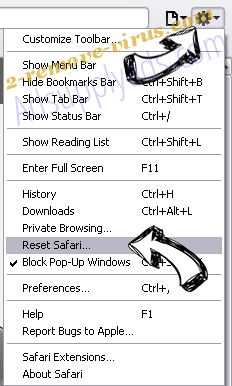
- Pick the options which you want to reset (often all of them are preselected) and press Reset.


- If you cannot reset the browser, scan your whole PC with an authentic malware removal software.
Site Disclaimer
2-remove-virus.com is not sponsored, owned, affiliated, or linked to malware developers or distributors that are referenced in this article. The article does not promote or endorse any type of malware. We aim at providing useful information that will help computer users to detect and eliminate the unwanted malicious programs from their computers. This can be done manually by following the instructions presented in the article or automatically by implementing the suggested anti-malware tools.
The article is only meant to be used for educational purposes. If you follow the instructions given in the article, you agree to be contracted by the disclaimer. We do not guarantee that the artcile will present you with a solution that removes the malign threats completely. Malware changes constantly, which is why, in some cases, it may be difficult to clean the computer fully by using only the manual removal instructions.
